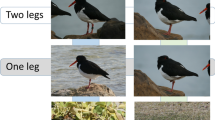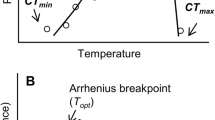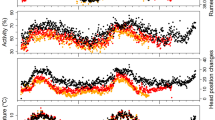Abstract
This observational study of captive Caribbean Flamingos (Phoenicopterus ruber) sought to investigate the possible functions of unipedal and bipedal resting. In particular, this research sought to further examine the possibility that thermoregulation is a primary function of unipedal resting. Significant negative correlations were found between length of unipedal resting and average temperature, and between length of unipedal resting and average heat index, indicating that temperature is a major factor in determination of resting stance. A significant negative correlation was also obtained between length of unipedal resting and average wind chill, but as the observed wind chills did not significantly differ from the temperatures, such a finding is to be expected. These results suggest that flamingos rest on one leg for longer intervals in an attempt to conserve body heat. Further, a significant positive correlation between length of bipedal resting and average wind speed suggests that on windy days, a bipedal stance is preferred to enhance stability when resting.
Zusammenfassung
Diese Studie von in Gefangenschaft gehaltenen Rosaflamingos (Phoenicopterus ruber) versucht, die möglichen Funktionen des Ruhens auf einem und auf zwei Beinen zu untersuchen. Insbesondere sollte die Möglichkeit, dass Thermoregulation eine Hauptfunktion des Ruhens auf einem Bein ist, geprüft werden. Signifikante negative Korrelationen wurden zwischen der Länge des Ruhens auf einem Bein und der Durchschnittstemperatur sowie zwischen der Länge des Ruhens auf einem Bein und dem durchschnittlichen Hitzeindex gefunden, was darauf hindeutet, dass die Temperatur beim Bestimmen der Ruhehaltung eine wesentliche Rolle spielt. Eine signifikante negative Korrelation wurde außerdem zwischen der Länge des Ruhens auf einem Bein und der durchschnittlichen Windkühle festgestellt, doch da die gemessene Windkühle nicht signifikant von der Temperatur abwich, kann man einen solchen Befund erwarten. Diese Ergebnisse deuten darauf hin, dass Flamingos für längere Zeitintervalle auf einem Bein ruhen, um Körperwärme zu konservieren. Ferner deutet eine signifikante positive Korrelation zwischen der Länge des Ruhens auf zwei Beinen und der durchschnittlichen Windgeschwindigkeit darauf hin, dass an windigen Tagen eine zweibeinige Ruhehaltung bevorzugt wird, um die Stabilität während des Ruhens zu verbessern.


Similar content being viewed by others
References
Altmann J (1974) Observational study of behavior: sampling methods. Behaviour 49:227–267
Anderson MJ (2009) Lateral neck-resting preferences in the lesser flamingo (Phoeniconaias minor). In: Childress B, Arengo F, Bechet A (eds) Flamingo, Bulletin of the IUCNSSC/Wetlands International Flamingo Specialist Group, No. 17. Wildfowl & Wetlands Trust, Slimbridge, UK, pp 37–39
Anderson M, Williams S (2010) Why do flamingos stand on one leg? Zoo Biol 29:365–374
Anderson MJ, Williams SA, Bono AJ (2009a, published online ahead of print) Preferred neck resting position predicts aggression in Caribbean flamingos (Phoenicopterus ruber). Laterality. doi: https://doi.org/10.1080/13576500903081814
Anderson MJ, Williams SA, O’Brien EH (2009b) Individual differences in preferred neck resting position of Caribbean flamingos (Phoenicopterus ruber). Laterality 14:66–78
Anderson MJ, Urbine JL, Wilson C, Calabro L (2011) Employment of web-based images and a live web cam in the examination of lateral neck-resting preferences in the American flamingo, Phoenicopterus ruber. J Caribb Ornithol (in press)
Baudinette R, Loveridge J, Wilson K, Mills C, Schmidt-Nielsen K (1976) Heat loss from feet of herring gulls at rest and during flight. Am J Physiol 230:920–924
Brown L (1959) The mystery of the flamingos. Country Life, London
Clark G Jr (1973) Unipedal postures in birds. Bird Banding 44:22–26
Dawson W, Hudson J (1970) Birds. In: Whittow GC (ed) Comparative physiology of thermoregulation, vol 1: invertebrates and nonmammalian vertebrates. Academic, New York, pp 233–310
Kahl M (1963) Thermoregulation in the wood stork, with special reference to the role of the legs. Physiol Zool 36:141–152
Kilgore DL Jr, Schmidt-Nielsen K (1975) Heat loss from ducks feet immersed in cold water. Condor 77:475–517
Leendert J (1991) Flamingo file. New Sci 1782:52
Ogilvie M (1991) Flamingo file. New Sci 1782:52
Ogilvie M, Ogilvie C (1986) Flamingos. Alan Sutton, Gloucester
Pickering S (1991) Flamingo file. New Sci 1782:52
Robinson R (2009) Balanced lifestyles. New Sci 2713:61
Smith W (1991) Flamingo file. New Sci 1782:52
Steadman R (1979) The assessment of sultriness. Part I: a temperature-humidity index based on human physiology and clothing science. J Appl Meteorol 18:861–873
Steen I, Steen J (1965) The importance of the legs in the thermoregulation of birds. Acta Physiol 63:285–291
Ting L, Chang Y (2009) Evidence for a passive stabilization during single-limb stance in flamingos. Paper presented at the 32nd annual meeting of the American Society of Biomechanics at Penn State University (August)
Williams SA, Anderson MJ (2010) The effect of pair bonding on neck-rest preferences in Caribbean flamingos. Poster presented at the 21st annual Saint Joseph’s University Sigma Xi student research symposium, Philadelphia, PA (April)
Yates D (1991) Flamingo file. New Sci 1782:52
Acknowledgments
The authors wish to express their gratitude to the Philadelphia Zoo for granting permission to observe the flamingos. In particular, we wish to thank Dr. Aliza Baltz, Curator of Birds, for her assistance throughout this project. We also thank Nielsen-Kellerman (Boothwyn, PA, USA) for their generous donation of the Kestrel 4000 Pocket Weather Tracker and tripod that were employed in this research. Partial funding for this work was provided by a Saint Joseph’s University Summer Scholars Program award.
Author information
Authors and Affiliations
Corresponding author
Additional information
Communicated by C. G. Guglielmo.
An erratum to this article can be found online at http://10.1007/s10336-012-0913-4.
Rights and permissions
About this article
Cite this article
Bouchard, L.C., Anderson, M.J. Caribbean Flamingo resting behavior and the influence of weather variables. J Ornithol 152, 307–312 (2011). https://doi.org/10.1007/s10336-010-0586-9
Received:
Revised:
Accepted:
Published:
Issue Date:
DOI: https://doi.org/10.1007/s10336-010-0586-9




